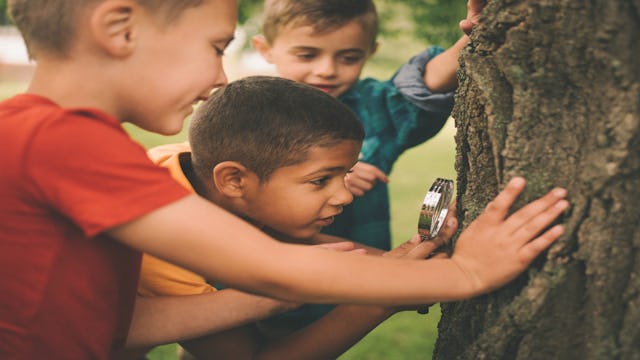City Kids Need Time In Nature Too, But They Aren't Getting Enough Of It

We all know that it’s good for kids to get out into nature. People pen popular books like Last Child in the Woods about the need to get more kids out into the wilderness; several major companies have joined the “natural playground” movement with “mountains, slides, rock climbs, gardens, sand pits, orchards, climbing walls, streams, caves, labyrinths, and other natural features that help children discover and learn about nature while they play.” Sites rhapsodize about how playing in dirt boosts the immune system. We’re told that we should be focusing more on our kids’ playing in the natural world than homework and tests.
These ideas are all well, good, and important. Exposure to nature is fundamental, so much so that a Japanese study notes: “Because we have already spent more than 99.99% of our evolutionary history in natural environments, it is thought that we are essentially adaptive to nature.”
This is true. Except all this chatter about how we need the wilderness, how our cortisol drops when we’re exposed to forests, how a walk in nature can improve short-term memory by 20%, how the woods can turn a boy into a man, forgets one thing: many children lack basic access to nature. They may even lack access to adequate greenspace, or to anything more than a mostly-concrete playground. When we champion nature, we leave these kids behind.
We’re not talking about a small number of kids here either. According to the site of the national PTA organization, a full one-third of all US children live in urban areas. Urbanites drive less — mass transit is available, and owning a car in a city can be an expensive pain in the ass. In fact, a study conducted by Nature in 2011: 62% of kids said they didn’t “have transportation to natural areas,” and 61% said “there were not natural areas near their home.” Consider, too, that kids from urban areas are more likely to belong to low-income families than suburban or rural kids, and you have a big group of kids for whom nature is all but inaccessible.
Think of it this way. Death Valley is one of my favorite places on earth. Imagine you lived nearby, in LA, with a young child. You can’t get there, even if you want to because you don’t drive. In fact, without a car, many of the recreation areas in LA are out of your kid’s reach. If you live in an apartment, your baby can’t go out and eat dirt from the flowerbeds, can’t boost his immune system with random microbes. Forget a stroll in the mountains; while the beach is better than nothing, it’s not exactly the same wilderness experience everyone’s extolling.
Business Insider says that “nature offers one of the most reliable boosts to your mental and physical well-being.” Which is great, but what if you have no access to it? They say that a study on depressed people found walks in nature boosted working memory “much more than walks in urban environments.” They quote another study that says people’s mental energy was restored after just looking at pictures of nature, but pictures of city scenes didn’t have the same effect.
They also say that nature can perhaps help to control ADHD symptoms — and as TIME Magazine says, kids from poor families are most likely to be diagnosed with ADHD. The poorer the kid, the more likely the diagnosis. These are the children most likely to benefit from being in nature — and they are least likely to have access to it.
And don’t look to the school to fill in where parents can’t. It’s a nice thought, but the Nature survey reveals that 75% of kids “reported they had little if any access to nature through school.” The National Wildlife Federation says that lately, the trend has been away from “outdoor time and outdoor learning.”
The one doing the heavy lifting, it seems, is the Parks and Recreation Department, with 9 out of 10 Parks and Rec Departments in the U.S. offering “out-of-school-time programs.” Most provide childcare, and 76% of those in urban areas also provide meals. These kids get “quality physical activity” and “nature education.” But the programs are in danger, facing funding issues, facility shortages, and inadequate staffing. They’re also not a trip to Yellowstone, a backyard to make mud pits, or a vast vista of nature to gaze upon. Basically, while they get kids on the grass, they aren’t necessarily a trip to the woods.
And contrary to what some might say, it isn’t as easy as “build[ing] a shelter from nature’s store” so kids can “forage” for food. It takes a lot of education and guidance to make sure kids are navigating the wild safely.
So it’s all well and good to say that kids need nature. They do. They need it desperately. But access to nature? That’s reserved for the privileged: the kids with backyards, the kids with mobility to visit national parks, the kids who can get out there and walk in the woods, however that happens. And city kids, particularly city kids living in poverty, are mostly at a loss when it comes to these things. Sure, there are some programs to get kids living in urban communities into the woods. But they are few, far between, and fleeting (think two weeks, not a lifetime).
If we believe so much in natural playgrounds, in forest kindergartens, in getting kids into nature, we need to get think hard — and work hard — to extend the same benefits to those who need it most, and who enjoy the least access to them.
This article was originally published on